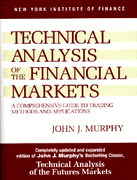|
|
This is an old revision of the document!
Table of Contents
Chaikin Money Flow
Introduction
Developed by Marc Chaikin, Chaikin Money Flow measures the amount of Money Flow Volume over a specific period. Money Flow Volume forms the basis for the Accumulation Distribution Line. Instead of a cumulative total, Chaikin Money Flow sums Money Flow Volume for a specific look-back period, typically 20 or 21 days. The resulting indicator fluctuates above/below the zero line just like an oscillator. Chartists weigh the balance of buying or selling pressure with the absolute level of Chaikin Money Flow. Additionally, chartists can look for crosses above or below the zero line to identify changes on money flow.
Calculation
There are four steps to calculating Chaikin Money Flow (CMF). The example below is based on 20 periods. First, calculate the Money Flow Multiplier for each period. Second, multiply this value by the period's volume to find Money Flow Volume. Third, sum Money Flow Volume for the 20 periods and divide by the 20-period sum of volume.
1. Money Flow Multiplier = [(Close - Low) - (High - Close)] /(High - Low) 2. Money Flow Volume = Money Flow Multiplier x Volume for the Period 3. 20-period CMF = 20-period Sum of Money Flow Volume / 20 period Sum of Volume
Each period's Money Flow Volume depends on the Money Flow Multiplier. This multiplier is positive when the close is in the upper half of the period's high-low range and negative when the close is in the lower half. The multiplier equals 1 when the close equals the high and -1 when the close equals the low. In this way, the multiplier adjusts the amount of volume that ends up in Money Flow Volume. Volume is in effect reduced unless the Money Flow Multiplier is at its extremes (+1 or -1).
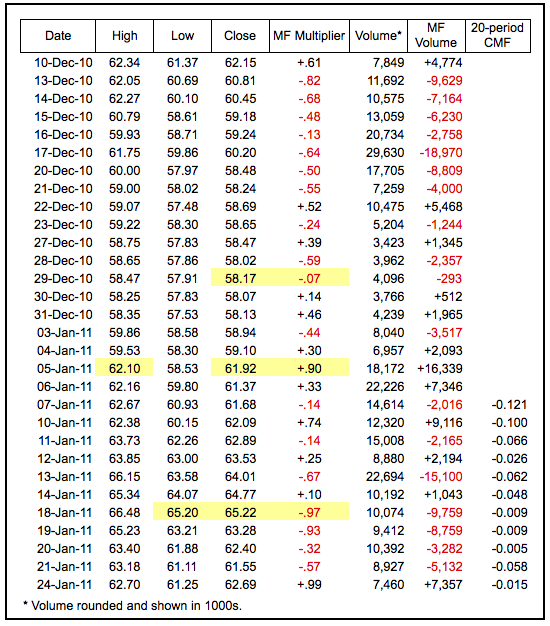
The table above shows some examples using daily data for Research in Motion (RIMM). Notice how the multiplier was near +1 on 5-Jan when the stock closed near its high. The multiplier dipped to -.97 on 18-Jan when the stock closed near its low. The multiplier finished near zero (-.07) when the stock closed near the midpoint of its high-low range on 29-Dec. Click here for a calculation example of Chaikin Money Flow in an Excel Spreadsheet.
Interpretation
Chaikin Money Flow (CMF) is an oscillator that fluctuates between -1 and +1. Rarely, if ever, will the indicator reach these extremes. It would take 20 consecutive closes on the high (low) for 20-day Chaikin Money Flow to reach +1 (-1). Typically, this oscillator fluctuates between -0.50 and +0.50 with 0 as the centerline.
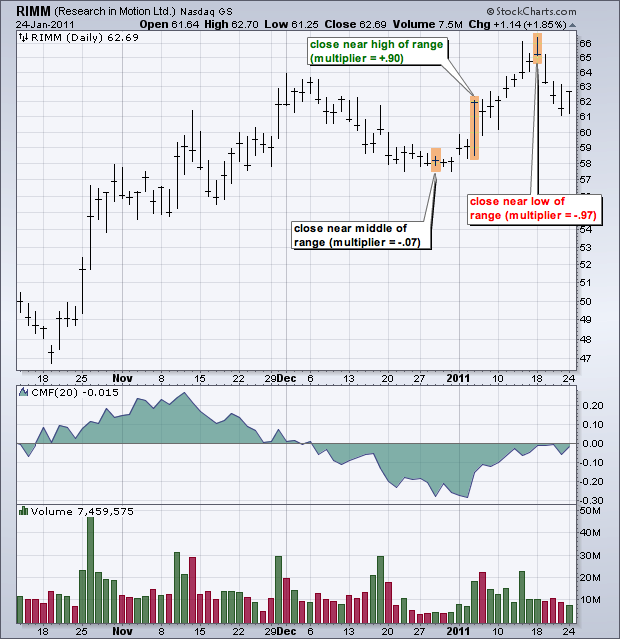
Chaikin Money Flow measures buying and selling pressure for a given period of time. A move into positive territory indicates buying pressure, while a move into negative territory indicates selling pressure. Chartists can use the absolute value of Chaikin Money Flow to confirm or question the price action of the underlying. Positive CMF would confirm an uptrend, but negative CMF would call into question the strength behind an uptrend. The reverse holds true for downtrends.
Buying/Selling Pressure
Chaikin Money Flow can be used to define a general buying or selling bias simply with positive or negative values. The indicator oscillates above/below the zero line. Generally, buying pressure is stronger when the indicator is positive and selling pressure is stronger when the indicator is negative.
While this zero line cross seems simple enough, the reality is much choppier. Chaikin Money Flow sometimes only briefly crosses the zero line with a move that turns the indicator barely positive or negative. There is no follow through and this zero line cross ends up becoming a whipsaw (bad signal). Chartists can filter these signals with buffers by setting the bullish threshold a little above zero (+0.05) and the bearish threshold a little below zero (-0.05). These thresholds will not entirely eliminate bad signals, but can help reduce whipsaws and filter out weaker signals.
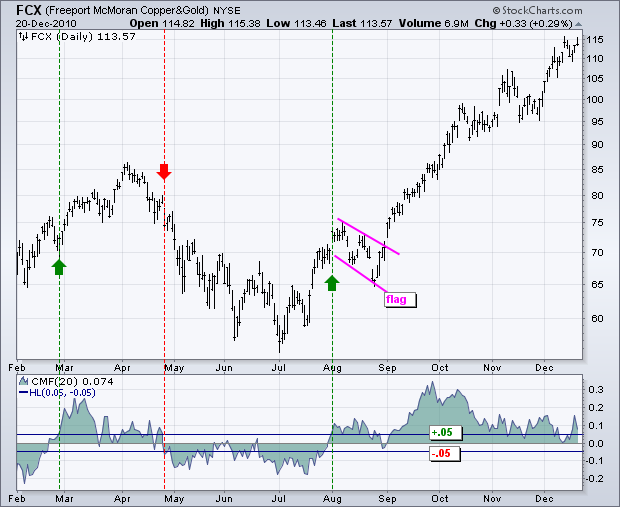
The chart above shows Freeport McMoran (FCX) with 20-day Chaikin Money Flow in the indicator window. There were at least 10 crosses of the zero line between February and December 2010. Adding a small buffer greatly reduced the number of bullish and bearish signals. A move above +0.05 was considered bullish, while a move below -0.05 was considered bearish. There were only three signals. While these signals will come a little later, it may be worth it to reduce whipsaw.
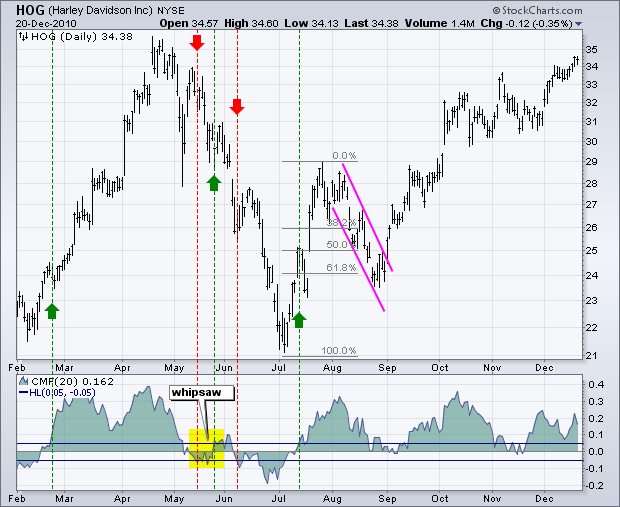
The chart for Harley-Davidson (HOG) shows a few good signals and a whipsaw with the May bounce. CMF moved above +0.05 for a few days, but this move failed to hold and the indicator broke back below -0.05 in early June. Whipsaws are going to happen, especially during volatile periods or when the trend flattens. CMF turned bullish in July and stayed bullish the rest of the year. Notice that HOG formed a falling wedge that retraced just over 62% in August, when CMF was still in bull mode. This pullback offered a second chance to partake in the CMF signal.
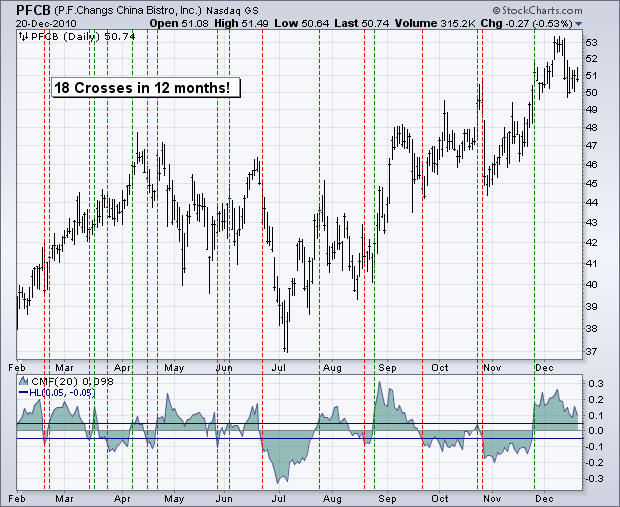
Chaikin Money Flow is not suited for all securities. The chart above shows P.F. Chang's (PFCB) with some 18 crosses above +0.05 or below -0.05. Basing CMF signals on these crosses resulted in one whipsaw after another. It is important to analyze the basic price trend and the characteristics of an indicator with a particular security. PFCB exhibits some trend, but price action within this trend is choppy and money flow cannot maintain a positive or negative bias. It would be better to find a different indicator for this stock.
Calculation Quirk
The Money Flow Multiplier in Chaikin Money Flow focuses on the level of the close relative to the high-low range for a given period (day, week, month). With this formula, a security could gap down and close significantly lower, but the Money Flow Multiplier would rise if the close were above the midpoint of the high-low range. The chart below shows Clorox (CLX) with a big gap down and a close near the top of the day's high-low range. Even though the stock closed sharply lower on high volume, Chaikin Money Flow rose because the Money Flow Multiplier was positive and volume was well above average. Ignoring the change from close-to-close means that Chaikin Money Flow can sometimes disconnect with price.
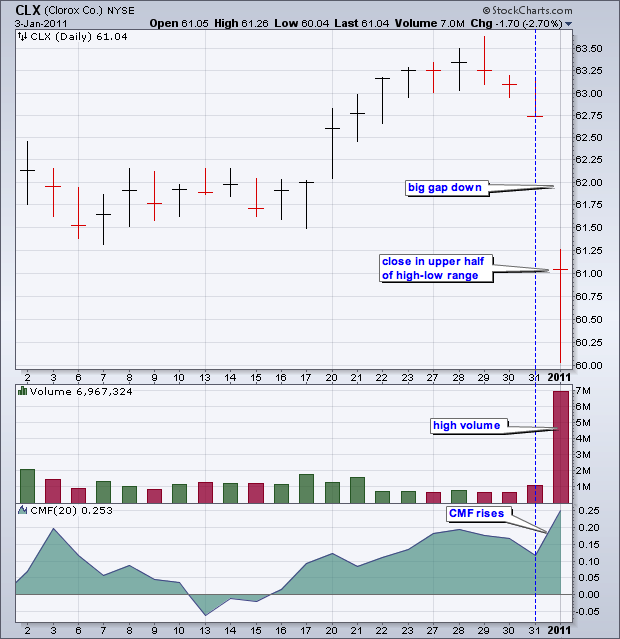
The opposite can happen when a security gaps up and closes near the low for the day. The chart below shows Travellers (TRV) gapping up and closing over 1% higher on the day. Despite this jump, the close was near the low for the day, which insured a Money Flow Multiplier near -1. As a result, almost all of the day's volume was counted as negative money flow and the Chaikin Money Flow fell.
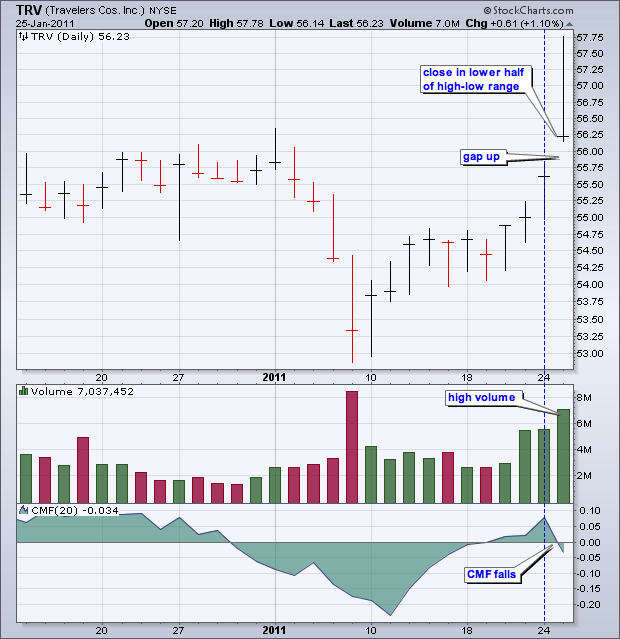
Conclusion
Chaikin Money Flow is an oscillator that measures buying and selling pressure over a set period of time. At its most basic, money flow favors the bulls when CMF is positive and the bears when negative. Chartists looking for quicker money flow shifts can look for bullish and bearish divergences. However, relying on CMF has risks. Selling pressure still has the edge in negative territory, even when there is a bullish divergence. This bullish divergence simply shows less selling pressure. It takes a move into positive territory to indicate actual buying pressure. As a money flow oscillator, CMF can be used in conjunction with pure price oscillators, such as MACD or RSI. As with all indicators, Chaikin Money Flow should not be used as a stand-alone indicator. Marc Chaikin also developed the Accumulation Distribution Line and the Chaikin Oscillator.
Using with SharpCharts
Chaikin Money Flow can be set as an indicator above or below the main window. Because it is shown in area format, it is not really suited for placement behind the security's price plot. Once the indicator is chosen from the dropdown list, the default parameter appears (20). These parameters can be adjusted to increase or decrease sensitivity. Users can click on “advanced options” to add horizontal lines, moving averages or other overlays. Chartists can even plot a second and longer Chaikin Money Flow indicator on top of the other. Periods of overlap show when money flow is strong for two different periods. Click here for a live example.
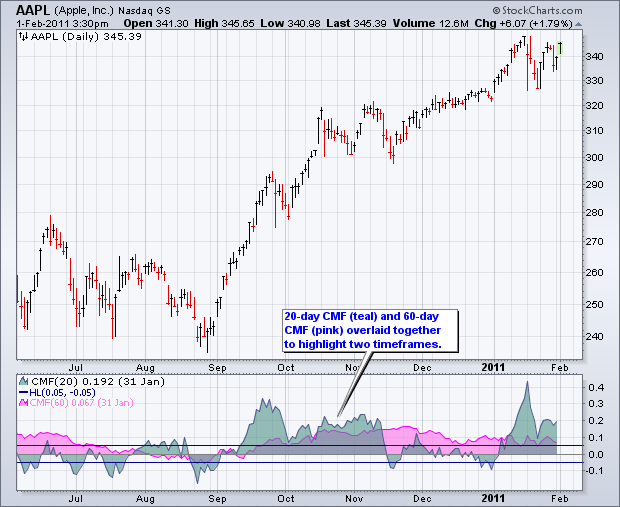

Suggested Scans
CMF Turns Positive and RSI Moves Above 50
This scan starts with a base of stocks that are averaging at least $10 in price and 100,000 in daily volume over the last 60 days. Accumulation and buying pressure is identified when Chaikin Money Flow moves into positive territory. Price momentum confirms when RSI moves above 50 (the centerline). This scan is meant as a starting point for further analysis and due diligence.
[type = stock] AND [country = US] AND [Daily SMA(60,Daily Volume) > 100000] AND [Daily SMA(60,Daily Close) > 10] AND [Daily CMF(20) crosses 0] AND [Daily RSI(14,Daily Close) crosses 50]
CMF Turns Negative and RSI Moves Below 45
This scan starts with a base of stocks that are averaging at least $10 in price and 100,000 in daily volume over the last 60 days. Distribution and selling pressure are identified when Chaikin Money Flow moves into negative territory. Price momentum confirms when RSI moves below 50 (the centerline). This scan is meant as a starting point for further analysis and due diligence.
[type = stock] AND [country = US] AND [Daily SMA(60,Daily Volume) > 100000] AND [Daily SMA(60,Daily Close) > 10] AND [0 crosses Daily CMF(20)] AND [50 crosses Daily RSI(14,Daily Close)]
For more details on the syntax to use for Chaikin Money Flow scans, please see our Scanning Indicator Reference in the Support Center.
Note: For the purposes of scanning, daily volume data is incomplete during the trading day. When running scans with volume-based indicators like CMF, be sure to base the scan on the “Last Market Close.” Examples of other volume-based indicators include Accumulation/Distribution, On Balance Volume, and the PVO.
Further Study
This book covers it all with explanations that are simple and clear. Murphy covers most the major charts patterns and indicators. A complete chapter is devoted to understanding volume and open interest.
Additional Resources
Stocks & Commodities Magazine Articles
Chaikin's Money Flow by Christopher Narcouzi
July 2000 - Stocks & Commodities
Comparing Seven Money Flow Indicators by Markos Katsanos
Jun 2011 - Stocks & Commodities

